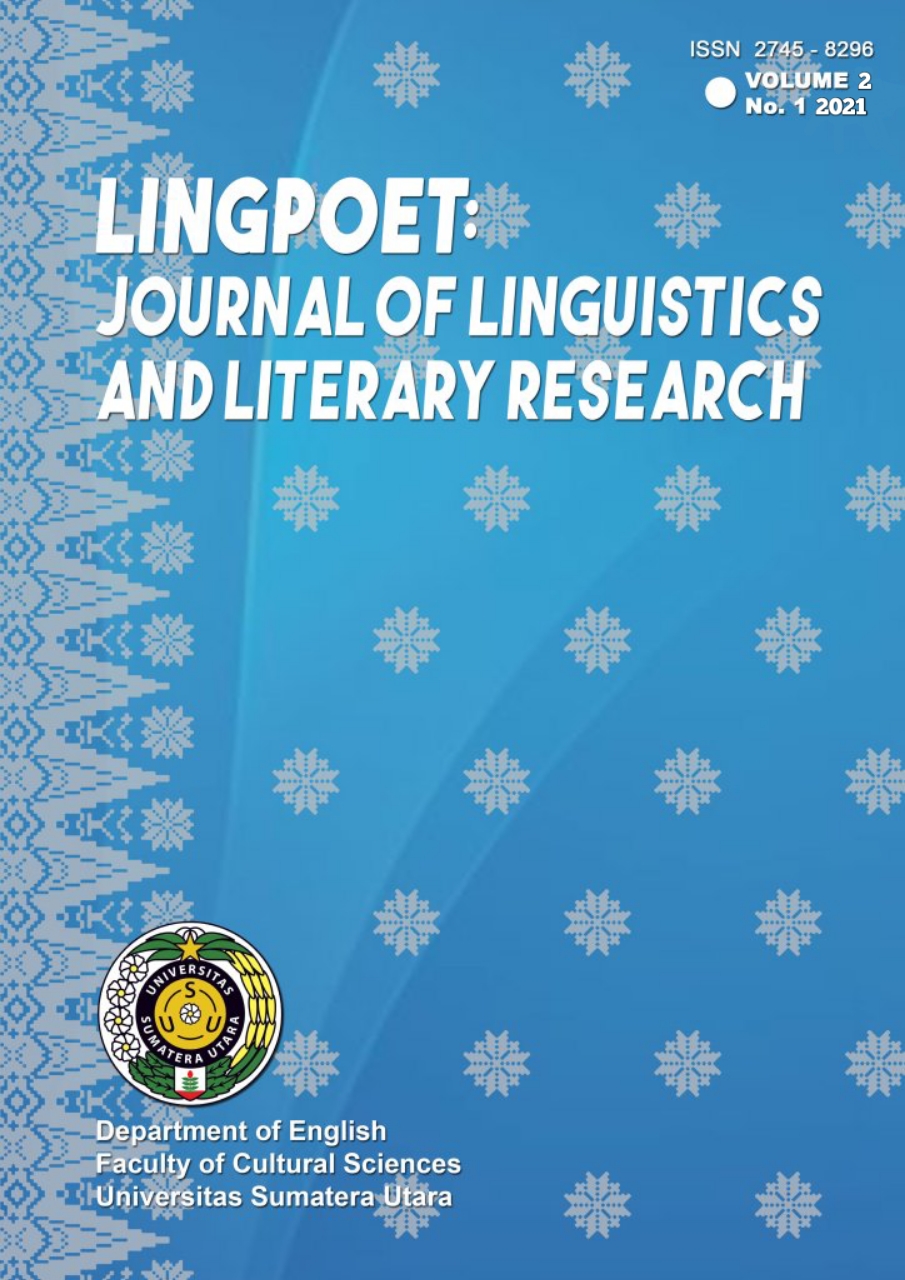Non-Verbal Communication Used by University Students’ Examinee in Thesis Proposal Seminar
DOI:
https://doi.org/10.32734/lingpoet.v2i1.5333Keywords:
non-verbal communication, semiotics, proposal seminarAbstract
This thesis entitled Non-Verbal Communication by University Students; Examinee In Thesis Proposal Seminar. Students have a proposal and final thesis examination where they present and explain the research that they have conducted. The researcher interested to provide views and further investigating the meaning of appearance which is expected to obtain a detailed picture of the meaning of non-verbal sign constructed on the meaning of the appearance by semiotic analysis. For this reason, this study aims at 1) To describe the kinds of non-verbal communications used by the student of English Department in the proposal seminar, and 2) To describe the meanings of the non-verbal communications used by the student of English Department in the proposal seminar. The theory of three basic semiotic elements proposed by Peirce (2003) is used to identify the sign action and also determined better the nature and rhetorical function of both verbal and non-verbal representation. The method used in this research is descriptive qualitative. The data of this research are the non-verbal communication of the students from the English department through their Facial Expression, Eye Contacts , Emblems, Adaptors and Body Action. The source of the data obtained one video from the seminar proposal. A semiotic visual image of signs, in the seminar proposal video. There are 7 kinds of non-verbal communication the student showed that obtained and observed by the researcher. The result of this research shows that five types of the non-verbal communications are found in the seminar, i.e. fear, amusement, agony, surprise and disgust. The most dominant type of non-verbal communication is the state of surprise with 2 expressions.
Keyword: Non-verbal Communication, Semiotics, Proposal Seminar
Downloads
References
Almohissen. Discursive and Visual Semiotic Analysis of Saudi Cartoons. Northeastern Illinois University: ProQuest Dissertations Publishing.2015
Ary, D et.al. Introduction to Research and Education. New York: Holt, Rinehart and Winston. 1979.
Broadbent, Goofrey. Design In Architecture. New York: John Willey and Sons.1980.
Chandler, D. Semiotics: The basic. New York: Rouledge. 2007.
Clandinin, D,J (ed). Handbook of narrative inquiry: Mapping a methodology. Thousand Oaks, CA: Sage. 2007.
Creswell, J.W. Research Method: Qualitative, Quantitative, and Mixed Methods Approaches Edition 4. London: SAGE. 2014.
Eco, Umberto. A theory of Semiotics.Kreasi wacana: Yogyakarta. 1979.
Harrison. “Visual social semiotics: Understanding how still images make meaning. Research Library. 2003.
F, Isnaini, B, Setyono, S, Ariyanto, “A visual semiotic analysis of multicultural values in an Indonesian English textbookâ€. Indonesiam Journal of Applied Linguistics, 8, 545-553. doi: 17509/ijal.v8i3.15253.2019.
Jappy, T. Introduction to Peircean Visual Semiotics. New Delhi: Bloomsburry. 2013.
R. Hanafiah, U. Mono, and M. Yusuf, “Code-switching in lecturer-students’ interaction in thesis examination: A case study in Indonesia,†INT J INSTRUCTION, vol. 14, no. 1, pp. 445–458, Jan. 2021, doi: 10.29333/iji.2021.14126a.
Medlej, J. “Human Anatomy Fundamentals: Mastering Facial Expressionsâ€. 2014, June 5. Retrieved from Design Tutplus: https://design.tutsplus.com/tutorials/human-anatomy-fundamentals-mastering-facial-expressions--cms-21140?_ga=2.190321259.1574346694.1546877615-623362627.1542085312 [Accessed: December 2019]
Miles, M.B, Huberman, A.M and Saldana, J. Qualitative Data Analysis, A Methods Sourcebook, Edition 3. London: Sage Publications. 2014.
Parsa, Alev FatoÅŸ. Visual semiotics: how still images mean? Interpreting still images by using semiotic approaches. Turkey: Ege university. 2009.
Peirce, C. S. Collected Papers of Charles S. Peirce (8 vols), C. Hartshorne, 1931–58.
Ramadhani. Emosi dasar dalam film (studi analisa semiotika dalam film animasi “inside outâ€). 2018.
Saussure, F.D. Cours de Linguistiquegenerale. Paris: Payot. 1983.
Sobur, Alex. Semiotika Komunikasi. Bandung : PT. Remaja Rosdakarya. 2003.
Sobur, Alex. Analisis Teks Media:Suatu Pengantar untuk Analisis Wacana, Analisis Semiotik, dan Analisis Framing. PT Remaja Rosdakarya: Bandung. 2004.
Sobur, Alex. Semiotika Komunikasi. Bandung : PT Remaja Rosdakarya. 2009.
Wekesa, Nyongesa Ben. Cartoons can talk? Visual analysis of cartoons on the 2007/2008 post election violence in Kenya: A visual argumentation approach. Discourse & Communication. 2012.
Downloads
Published
How to Cite
Issue
Section
License
Copyright (c) 2021 LingPoet: Journal of Linguistics and Literary Research

This work is licensed under a Creative Commons Attribution-ShareAlike 4.0 International License.













